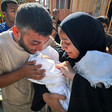16 September 2023

Palestinians carry the body of a Fatah fighter who was killed during clashes with Islamist fighters in Ein al-Hilweh refugee camp in Sidon, Lebanon, 14 September.
EFEA tentative calm is holding in Ein al-Hilweh after a ceasefire was declared Thursday night, ending the latest episode of violence disrupting life in the largest Palestinian refugee camp in Lebanon and the nearby city of Sidon.
Intense battles between fighters with the Palestinian faction Fatah and Islamist militias based in the camp have repeatedly broken out since late July.
The last days of that month witnessed the attempted killing of Mahmoud Khalil, an Islamist fighter (one of his companions was killed instead), and the apparent reprisal assassination of Abu Ashraf al-Armoushi, a Fatah military commander, and four of his bodyguards.
Thirteen people were killed in the days that followed.
Fatah has demanded the surrender of fighters suspected of involvement in al-Armoushi’s 30 July assassination.
Seven fighters were reported killed in Ein al-Hilweh on 13 September alone.
On 10 September, artillery fire from inside the camp reportedly struck two Lebanese army bases, injuring five soldiers, one seriously.
According to UNRWA, the UN agency for Palestine refugees, at least 18 people have been reportedly killed and some 140 people injured in Ein al-Hilweh since 7 September.
Some 60,000 people live in Ein al-Hilweh, among them at least 35,000 Palestinian refugees registered with UNRWA.
The camp is surrounded by a concrete wall complete with watchtowers and checkpoints through which the Lebanese army controls movement in and out of the camp. But under an annulled but still observed 1969 Cairo Accord, the army does not operate inside Ein al-Hilweh.
As The New Arab explains, “while the camp remains under Lebanon’s sovereignty, its practical governance lies with Palestinians.”
“This means that security and administration within the camp fall under the jurisdiction of popular committees and Palestinian factions and it serves as a hub for numerous rival armed groups.”
Being the largest Palestinian refugee camp in Lebanon, control of Ein al-Hilweh is seen as a major prize.
The publication adds that “while Fatah, the main faction of the [Palestine Liberation Organization], has traditionally held influence over Palestinian camps in Lebanon, its leadership has faced challenges in recent years.”
“In this context, maintaining control over Ein al-Hilweh is vital to reaffirming their leadership.”
And while factions vie for control over the camp, its population remains destitute and disenfranchised.
For decades, Lebanon has prevented Palestinian refugees – people who were expelled from their homeland by Zionist militias around the time of Israel’s founding in 1948 and their descendants – from integrating economically and socially.
Lebanon is meanwhile reeling from its own devastating economic crisis. Amid that crisis and an influx of Syrian refugees from the war in that country, Palestinians who have been in Lebanon for decades are perhaps its most marginalized population.
Israel also bears much responsibility for the worsening plight of Palestinians in Lebanon.
Palestinian refugees in Lebanon remain as such because Israel refuses to allow them to exercise their right of return to their homeland, as enshrined in international law, because they are not Jews.
With few other means of survival, some young people take up arms in exchange for a stipend from one of the camp’s political factions, Fatah being the most prominent among them. Ghettoized Ein al-Hilweh has a reputation for lawlessness and brief episodes of factional fighting are nothing new.
Regional dynamics
However, regional dynamics are fueling the current instability in Ein al-Hilweh, and so there is more at stake than a factional turf war this time around.
A prevailing analysis holds that Hizballah and Hamas view the recent fighting between Fatah and Islamist forces as an opportunity to weaken Fatah.
The Lebanese Shia resistance group Hizballah, supported by Iran, has tremendous influence over what happens in southern Lebanon, where Sidon is located.
The anti-Shia Islamist groups fighting Fatah in Ein al-Hilweh have previously engaged in battle with Hizballah in Syria. Despite this inherent enmity, Hizballah may find temporary utility in the Islamist groups, with which its close ally Hamas has good relations, as a battering ram against Fatah.
A weakened Fatah, this analysis holds, would help push back against the normalization agenda and allow for the strengthening of the resistance axis in Lebanon’s camps ahead of any regional confrontation with Israel.
A geographic and political rift separates Fatah, whose leader Mahmoud Abbas presides over the Palestinian Authority in the West Bank, and Hamas, which is seeking to spread armed resistance from Gaza to the West Bank.
The Palestinian Authority meanwhile serves as a policing arm for the Israeli occupation by arresting armed resistance operatives in the West Bank.

A Palestinian woman wounded in clashes between Fatah and Islamist fighters in Ein al-Hilweh rests at an UNRWA classroom in Sidon, southern Lebanon, on 11 September.
EFEMajed Faraj, the Palestinian Authority intelligence chief, visited Lebanon and met with high-ranking government officials shortly before the assassination of Abu Ashraf al-Armoushi and the ensuing clashes. The proximity of his visit to the current unrest in Ein al-Hilweh has propelled speculation that Ramallah played a role in its instigation.
All the while, an increasing number of Arab states are normalizing relations with Israel, further marginalizing the Palestinian liberation struggle, despite widespread rejection of normalization among the Arab public.
A headline in the Lebanese paper Al-Akhbar from Wednesday asks: “Ein al-Hilweh: Does a ceasefire depend on the reconciliation of Fatah and Hamas?”
Deepened humanitarian crisis
While plenty of ambiguity remains, intra-Palestinian and regional complexities are certainly playing out in the neighborhoods of Ein al-Hilweh, the boundaries of which are flashpoints of confrontation.
In August, UNRWA stated that “this localized escalation of violence in the camp, which is located within the country’s third largest city, needs to be understood in the context of regional, intra-Palestinian and host country political dynamics.”
“The camp has come to be a magnifier of different actors vying for power and control,” UNRWA added.
“Humanitarian needs amongst camp residents are high and rising, driven largely by systemic discrimination over generations, failed governance structures, unprecedented financial and economic crises affecting the country, and the social and economic inequality experienced by Palestine refugees.”
Given the protracted nature of the contradictions contributing to the violence over the past months, some close to the situation in Ein al-Hilweh reportedly believe that the fighting will continue.
In the meantime, UNRWA, which provides government-like basic services to Palestinian refugees in Lebanon, is on the verge of collapse after years of chronic underfunding amid increased need.
The consequences of an implosion of UNRWA is hard to fathom, as it would reverse decades of human development gains and likely cause upheaval in both Palestine and host countries – particularly, as the International Crisis Group, a think tank that reflects US and other Western agendas, observes, “if Palestinians perceive that cuts signal the loss of their refugee status.”
All of UNRWA’s eight schools housed in two compounds in Ein al-Hilweh have been turned into bases for armed groups, preventing the return of nearly 6,000 students when the new academic year begins early next month.
The agency hopes to upgrade other UNRWA schools to accommodate Palestinian refugee children in the camp.
As of Thursday, four UNRWA installations serving as temporary shelters for residents displaced by fighting were nearing their full capacity.
Some displaced residents were staying with relatives in the Sidon area or in other camps or areas in Lebanon.
Specter of Nahr al-Bared
Ein al-Hilweh hasn’t been subjected to total destruction, as was the case in Nahr al-Bared, in northernmost Lebanon, during and after a months-long battle between the Lebanese Army and Salafi fighters that had infiltrated the refugee camp in 2007.
More than 27,000 Palestinian refugees were forced from their homes in Nahr al-Bared, and thousands remain displaced years later.
While the fate of Nahr al-Bared has not fallen on Ein al-Hilweh, as some had feared, especially after the life-threatening injury of a soldier, the ramifications of the current violence will reverberate far beyond the camp.
According to a report published by the Lebanese paper An-Nahar in early August, “the Palestinian Authority is aiming to consolidate its control over the Palestinian refugee camps in Lebanon, in an effort to foil Hamas’ attempts to overtake them.”
The paper added that the clashes “could pave the way to further violence, most notably the Fatah movement’s demise.”

A deserted street and damaged buildings after heavy clashes between Fatah and Islamist fighters in Ein al-Hilweh, 2 August.
DPAThat doesn’t appear to have happened. However, Hamas, with the protection of Hizballah, has leveraged the crisis in Ein al-Hilweh “to position itself as a mediator or influencer in ceasefire and security arrangements,” as Lebanese journalist Souhayb Jawhar has pointed out.
A revival of the call to disarm Palestinian factions in Lebanon is likely in the wake of the Ein al-Hilweh fighting.
After a bloody civil war and Israeli invasion in the 1970s and ’80s, there are fears among some sectors in Lebanon that an increased presence of Palestinian resistance groups in the country will turn it once again into an arena for Palestinian armed confrontation with Israel.
This week 41 years ago, fighters with the Israel-allied Lebanese Forces militia massacred as many as 3,000 Palestinian refugees in the Sabra and Shatila refugee camps in Beirut.
The slaughter was made possible after a US-brokered ceasefire agreement reached weeks earlier stipulated that the Palestine Liberation Organization had to withdraw its military and political personnel from Lebanon, leaving civilians in the camps defenseless.
Meanwhile, tensions between Hizballah and Israel have heightened along Lebanon’s southern border in recent months, ripening conditions for another full-blown confrontation like the 2006 war that resulted in more than 1,100 fatalities in Lebanon, the vast majority of them civilians, and the deliberate destruction of civilian infrastructure in the country.
That war ended in an unprecedented military defeat for Israel (Haaretz military analyst Amos Harel branded it “a resounding failure”) and marked a “historic and strategic accomplishment” for the resistance, according to Hizballah leader Hassan Nasrallah.





